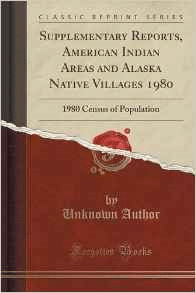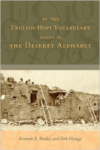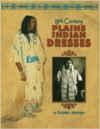Description
Excerpt from Supplementary Reports, American Indian Areas and Alaska Native Villages 1980: 1980 Census of Population
This report presents 1980 census counts of the total and American Indian populations for identified American Indian areas which include reservations, tribal trust lands (off reservation), and the historic areas of Oklahoma (excluding urbanized areas). Counts are also shown for the total, American Indian, Eskimo, and Aleut populations in Alaska Native villages and in Alaska Native regional corporations. Summaries are provided for the United States, regions, divisions, and States. The report contains information on the number of occupied housing units (or households) with an American Indian householder or spouse; comparable data are presented for households in Alaska, with an American Indian, Eskimo, or Aleut householder or spouse.
The types of identified American Indian areas and Alaska Native villages recognized in the 1980 census were based on recommendations of the Office of Management and Budget Task Force on Indian Census, consultations with American Indian tribal governments and organizations, and State governments. The 1980 census is the first decennial census to identify all Federal and State American Indian reservations and the other American Indian areas and Alaska Native villages shown in this report. (In the 1980 census, 278 reservations were identified; the 1970 census identified 115.) This is the first 1980 census report to present data on tribal trust lands, the historic areas of Oklahoma (excluding urbanized areas), and Alaska Native regional corporations.
Information on American Indians, Eskimos, and Aleuts was derived from answers to the 1980 census race item. (See the facsimile of item 4 under Definitions and Explanations.) The concept of race as used by the Census Bureau reflects self-identification by respondents; it does not denote any clear-cut scientific definition of biological stock.
Identified Areas – For the 1980 census, reservations and their boundaries were identified by the Bureau of Indian Affairs (Bia) and State governments. American Indian reservations are areas with boundaries established by treaty, statute, andor executive or court order. Some American Indian reservations have tribal trust lands in the vicinity of the reservation which are located outside the reservation boundary (off reservation). These lands also were identified by the Bia for the 1980 census.
The identified historic areas of Oklahoma (excluding urbanized areas) consist of the former reservations which had legally established boundaries during the period 1900-1907. These reservations were dissolved during the 2 to 3 year period preceding the statehood of Oklahoma in 1907.
Identified Alaska Native villages constitute tribes, bands, clans, groups, villages, communities, or associations in Alaska which were listed in sections 11 or 16 of the Alaska Native Claims Settlement Act, Public Law 92-203, or which met the requirements of the Act and which the Secretary of Interior determined were, on the 1970 census enumeration date (April 1), composed of 25 or more Alaska Natives.
Alaska Native regional corporations are corporate entities organized to conduct business for profit, pursuant to the Alaska Native Claims Settlement Act, P. L. 92-903, as amended by P.L. 94-204, and consist of a portion of the State of Alaska composed, as far as practicable, of Alaska Natives with a common heritage and interest.
The statistics for some reservations and Alaska Native villages shown in this report differ from those published in the 1980 Census of Population, General Population Characteristics, Pc 80-1-B, and the 1980 Census of Housing, General Housing Characteristics, Hc 80-1-A. Data in this report for a few reservations, two Alaska Native villages, and two counties in the historic areas of Oklahoma (excluding urbanized areas) include corrections made after the final 1980 .






Reviews
There are no reviews yet.